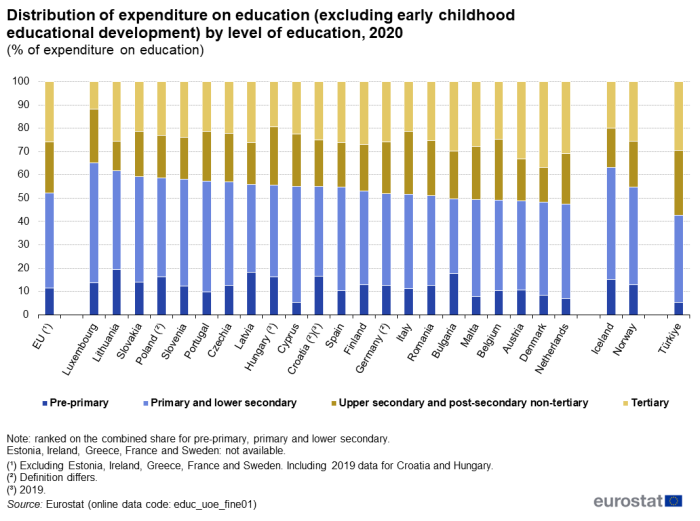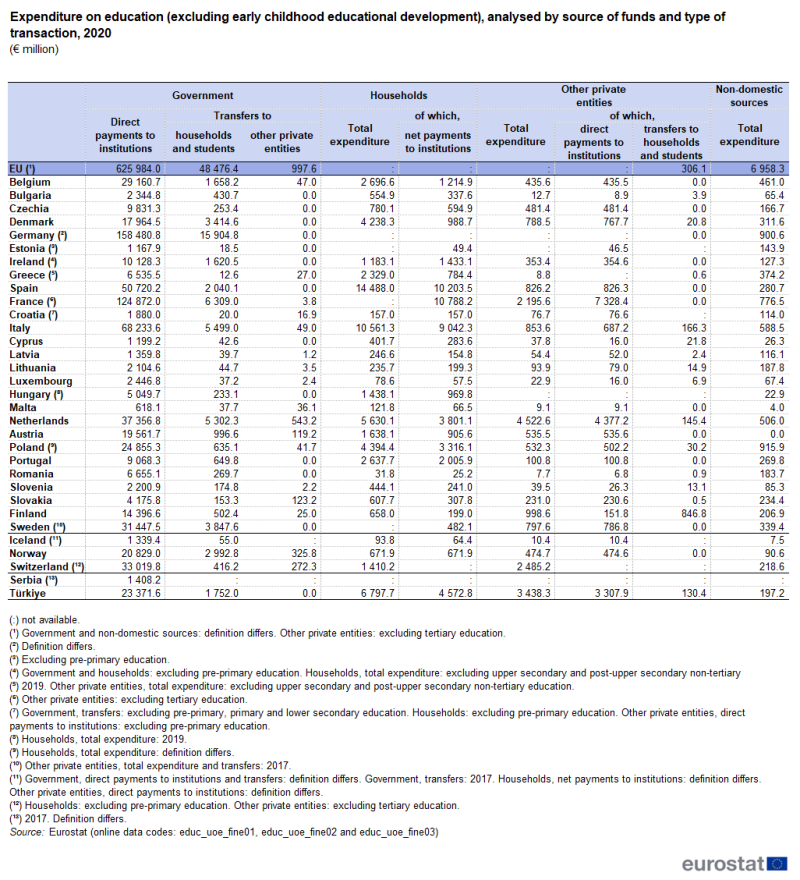
Overall educational expenditure
Among EU Member States, the funding of education mainly comes from government, with a smaller role for private sources (including households, enterprises, non-profit organisations and religious institutions), while an even smaller role is generally played by non-domestic sources (including international organisations such as the United Nations or the World Bank).
- The share of total spending on education in 2020 coming from governments ranged among the EU Member States from 71 % in Greece to 97 % in Romania. It should be noted that some government expenditure relates to payments and transfers for education to the non-educational private sector – this includes subsidies to households and students, as well as payments to other non-educational private entities. As such, this part is counted twice, once in government expenditure and a second time in the expenditure of households and other non-educational private entities.
- The share of non-educational private sources was within the range of 20–25 % in Portugal, Spain, Hungary and Greece, and was highest at 25.1 % in Greece.
- The share of expenditure on education that came from non-domestic sources was highest in Lithuania (7.0 %) and Latvia (6.4 %); elsewhere its share was at most 5.0 % and often below 3.0 %.
The highest overall levels of government expenditure on educational institutions were unsurprisingly recorded in the most populous EU Member States: in 2020, expenditure peaked at €158.5 billion in Germany, followed by €124.9 billion in France. Figure 2 provides more information on public expenditure on education, while Table 2 as well as Figures 3 and 4 provide more information on expenditure on educational institutions, not just from government but also from other sources.
The share of public education expenditure that was used for financial aid to households and students was 7.2 % across the EU in 2020; see also Figures 5 to 7 later.
 SDG 4: Quality Education
SDG 4: Quality Education
Analysis
1. The issues highlighted in the article are mainly related to education expenditure and financial aid to households and students. These issues are connected to SDG 4: Quality Education, which aims to ensure inclusive and equitable quality education for all.
2. Based on the article’s content, the specific targets under SDG 4 that can be identified are:
– Target 4.1: By 2030, ensure that all girls and boys complete free, equitable and quality primary and secondary education leading to relevant and effective learning outcomes.
– Target 4.5: By 2030, eliminate gender disparities in education and ensure equal access to all levels of education and vocational training for the vulnerable, including persons with disabilities, indigenous peoples and children in vulnerable situations.
– Target 4.a: Build and upgrade education facilities that are child, disability and gender sensitive and provide safe, non-violent, inclusive and effective learning environments for all.
3. The article mentions indicators that can be used to measure progress towards the identified targets:
– Indicator 4.1.1: Proportion of children and young people achieving at least a minimum proficiency level in reading and mathematics.
– Indicator 4.5.1: Parity indices for education indicators, including gender, rural/urban, wealth quintile, disability status, indigenous peoples, and conflict-affected areas.
– Indicator 4.a.1: Proportion of schools with access to electricity, internet, computers, adapted infrastructure for students with disabilities, basic drinking water, single-sex basic sanitation facilities, and basic handwashing facilities.
These indicators provide quantitative measures to assess the achievement of the targets related to education expenditure and financial aid.
Overall, the article highlights the importance of investing in education and ensuring equal access to quality education for all individuals. The identified SDGs, targets, and indicators provide a framework for monitoring progress and promoting inclusive and equitable education systems.
Copyright: Dive into this article, curated with care by SDG Investors Inc. Our advanced AI technology searches through vast amounts of data to spotlight how we are all moving forward with the Sustainable Development Goals. While we own the rights to this content, we invite you to share it to help spread knowledge and spark action on the SDGs.
Fuente: ec.europa.eu

Join us, as fellow seekers of change, on a transformative journey at https://sdgtalks.ai/welcome, where you can become a member and actively contribute to shaping a brighter future.







